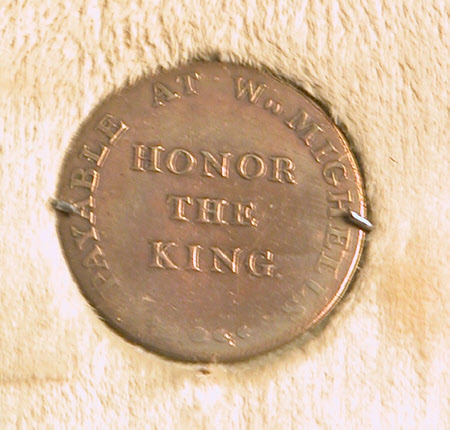A halfpenny token for W. Mighell
William Lutwyche (active 1790s)
Category
Coins and medals
Date
1796
Materials
Copper
Measurements
28.3 mm (Diameter)
Place of origin
Birmingham
Order this imageCollection
Anglesey Abbey, Cambridgeshire
NT 517662.10
Summary
Copper, A halfpenny token for W. Mighell, William Lutwyche (active 1790s), Birmingham, 1796. A halfpenny trade token made at the manufactory of William Lutwyche in Birmingham, for the Sussex ceramics merchant W. Mighell. On the obverse is a legend confirming that the token will be accepted by Mighell, together with the patriotic call to ‘Honor the King’. On the reverse is the denomination, date and place of issue of the token. Mounted in a frame with ten other medals and tokens commemorating and celebrating King George IV (1762-1830, reigned 1820-30) (NT 517662).
Full description
Tokens were issued periodically in the British Isles from the seventeenth through to the nineteenth centuries. Tokens are units of money used in substitution for the official coinage, and were generally produced because there was insufficient official small denomination coin in circulation. By the eighteenth century they also began to be collected and so many were minted for the collectors’ market. This token is one of a group of three in the collections at Anglesey Abbey (for the others, see NT 517662.8 and 9), and carries a halfpenny denomination. Whereas one of the tokens in the group (NT 517662.8) was almost certainly made for collectors, the present example is a genuine trade token. Designed and struck in the manufactory of William Lutwyche in Birmingham, it was made for a Sussex merchant, W. Mighell, in the fishing village of Brighthelmstone, which would soon become swallowed by modern Brighton. The Mighell family is first recorded in the sixteenth century in Brighton, where they became prominent nonconformists in the eighteenth and nineteenth centuries: many Mighell children were baptised in the Union Street Independent Chapel from 1700. Very little is known about W (William?) Mighell, who was described as a grocer when declared bankrupt in 1782 (Gentleman’s Magazine, 52 (1782), p. 264); he had re-established himself by 1791, when he was listed in Brighthelmstone as running an ‘earthen-ware-house’, presumably some form of pottery business (Universal British Directory, p. 374). His relative Philip Mighell (1747-1836), perhaps his brother, leased and later sold to the Prince Regent land that now forms part of the west lawn of the Royal Pavilion, whilst Philip’s nephew Richard (1794-1865), possibly W. Mighell’s son, would later become a large-scale urban property owner and builder in Brighton, participating in the development of the suburb Cliftonville. Jeremy Warren, 2020
Provenance
Bequeathed to the National Trust by Huttleston Rogers Broughton, 1st Lord Fairhaven (1896-1966) with the house and the rest of the contents in 1966.
Credit line
National Trust Collections (Anglesey Abbey, The Fairhaven Collection)
Marks and inscriptions
Obverse: Centre: HONOR THE KING Legend around edge: PAYABLE AT W. MIGHELLS Reverse: BRIGHTHELMSTONE / HALFPENNY / 1796
Makers and roles
William Lutwyche (active 1790s), medallist
References
Dalton and Hamer 1910-18, 1996: Richard Dalton and Samuel H. Hamer, The Provincial Token-Coinage of the 18th Century, 1910-18, edited by Allan Davisson, Cold Spring 1996, p. 255, no. 10 Withers 2010: Paul and Bente R. Withers, The Token Book. British Tokens of the 17th 18th and 19th centuries and their values, Llanfyllin 2010, p. 334, no. 10 Dykes 2011: David Wilmer Dykes, Coinage and Currency in Eighteenth-Century Britain. The Provincial Coinage, London 2011, p. 218, fig. 209
